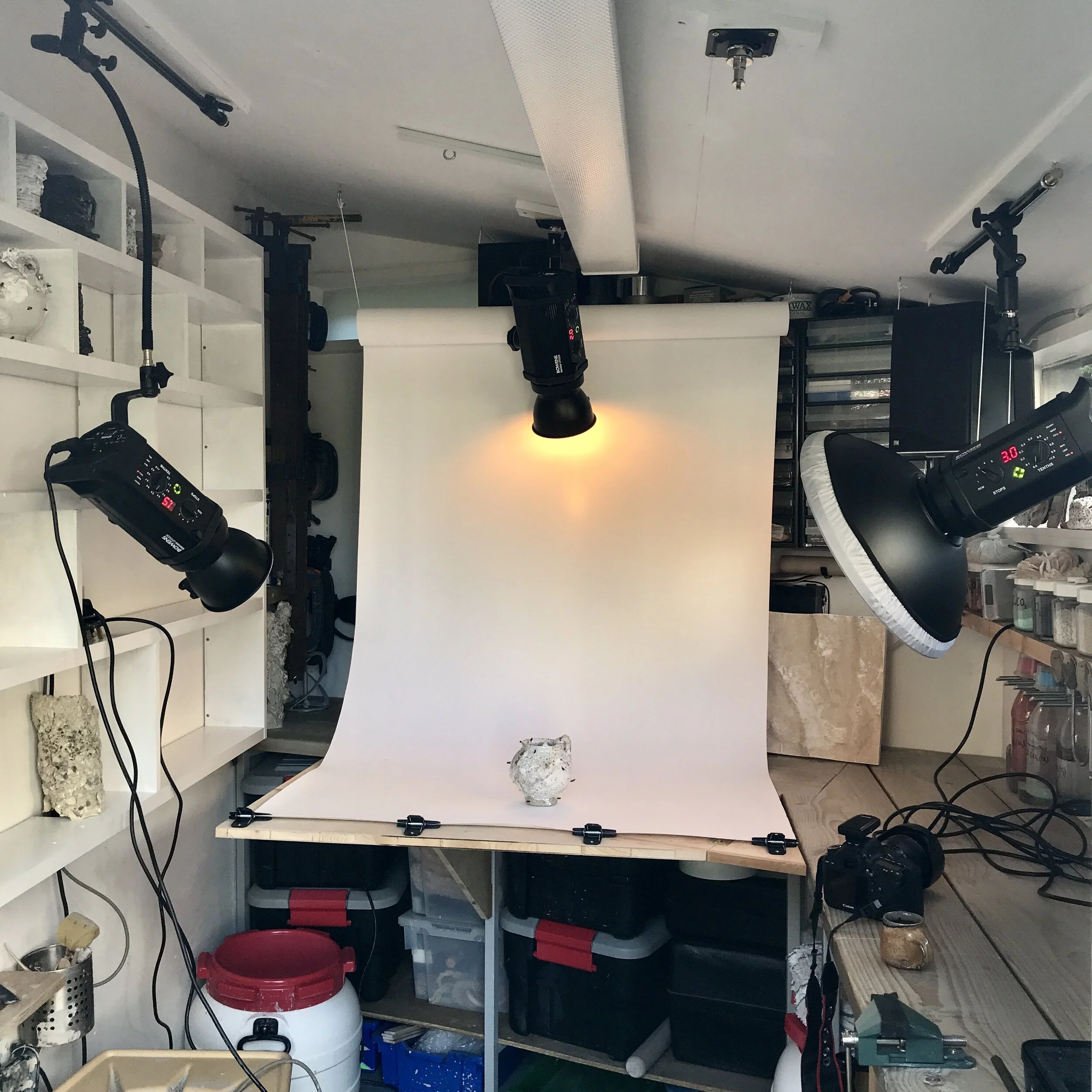Hunches and Proof
Having handled the Ostend Clay and been surprised at how silky smooth it felt, and how pale it fired to 1000°C, I was less surprised to see it melt at 1260°C. ‘Wild Clay’ has often picked up so many impurities, and these have been ground so fine (usually through glacial action) that it is almost inevitable that a top temperature of 1100°C is far more reasonable to expect.
That initial test was of the clay in its raw state, unrefined and literally dug from the cliff, formed into a coil, and placed directly in the kiln. I had gathered in the region of fourteen kilograms of the stuff, and had dried it, broken it into small sugar-cube-sized lumps, before adding it to large buckets of water. The clay can then ‘Slake’ down into a silt, and the water usually penetrates the dried clay lumps very quickly (much more so than if the clay were left wet and submerged in water). This is standard practice when refining foraged clays.
This clay was still to offer yet more surprises, however, and even after five days slaking, only the surface of each lump was soft. - Inside, each hard-packed lump of clay was still dry(!)
It is at this point that Potters turn to a tool known as a ‘Blunger’ this heavy duty mechanical mixer made short work of the clay and the resultant homogenous slip was ready for sieving.
Incredibly, the slip just fell through the 60 mesh sieve with virtually no resistance and hardly any need to brush it through. After sieving around twenty litres of thick clay slip through a sieve only 15cm in diameter, there was barely enough sand and 3mm grit to cover the circle in the thinest of layers. - I have sieved wild clays before and removed huge volumes of stone and sand, grit and roots, but not so here.
As I poured the refined clay slip into the plaster bath for drying it felt Thixotropic, almost oily, definitely slick, and there was a faint odour of sulfur-dioxide. The rotten egg smell might not seem so surprising given that the clay had been slaking for nearly a week in the summer heat, but there was so little organic matter in the sample that I wondered if the presence of Sulfur was a contributing factor in the low meting temperature as seen in my initial firing tests. Joe later buzzed me a message saying that Sulfur is “…a very strong and acidic Oxide with a very low melting point…”
In a parallel part of this research, I had been reading a lot about Calcium Carbonate, or ‘Whiting’ as potters often call it, and thinking about how to make use of this material which i knew could be calcined diectly from seashells. - North Norfolk has had a thriving cockle and whelk industry for centuries and there seemed to be a nice tie-in here… During this reading I remembered learning that Calcium Carbonate decomposes to Calcium Oxide above 840°C, and that the calcium oxide acts as a strong flux at higher temperatures.
It occured to me that, with so much of the surrounding geology of Norfolk being chalky, perhaps this cliff clay was also particularly high in chalk (calcium carbonate).
I knew chalk was a base (alkali), so started to research what effect different acids might have on the clay. By remarkable coincidence, I happened to have purchased five litres of Phosphoric Acid some years back for cleaning the rust from my steel sash cramps. Phosphoric Acid reacts with Calcium Carbonate to produce Carbon Dioxide, Water, and Tri-Calcium Phosphate. This exothermic reaction was already sounding promising before I realised that Tri-Calcium Phosphate is what is commonly used as a synthetic substitute for Bone Ash in modern recipes for Bone China(!!).
One of the peculiarities of Bone China is that it is normal to High bisque fire (to around 1240°C) ,and then Low glaze fire (to around 1060°C), so I immediately knew that IF Tri-Calcium Phosphate is a high volume ingredient of Bone China then this conversion in my own clay might raise the maturation point of the clay.
It turns out that a traditional Bone China recipe has 50% Bone Ash, and the typical analysis of Bone Ash is 67-85% calcium phosphate, 3-10% calcium carbonate… Even more intriguing!
I was beginning to think that Calcium Carbonate to Tri-Calcium Phosphate transformation might have a REALLY beneficial effect on the Ostend Cliff Clay.
But, so far at least, this had all been theory. With some trepidation, I set up the camera to record what I hoped would be, while perhaps not dramatic, at least a visible reaction. I took some precautions: A metal tray under the plastic dishes, just in case the exothermic reaction was so hot that it melted through the tupperware. Plastic spoon and tub for the Phosphoric Acid (it had been sold to me in a plastic container, so I knew that was safe). I checked online to see that Phosphoric Acid only begins to etch glass above 200°C, and that stainless steel would not react to the acid and contaminate the clay… Ready!
True to expectations, the clay fizzed away quite energetically as soon as the acid hit it, and the tub warmed up too.
And this is how ‘adventurous’, ‘experimental’ ceramists spend their evenings and weekends: Reading, connecting-the-dots, letting the materials guide them, learning, and testing…
So far the theory of this clay containing a lot of chalk/whiting/calcium-carbonate, was holding true, the evidence from the reaction with Phosphoric Acid was compelling and appeared to warrant pursuing further. I dried this modified clay on a plaster batt, and set up a control for the next firing.
Knowing that the original Ostend Clay sample had melted completely at 1260°C, I settled on a lower firing to 1200°C, on the off-chance that it might retain some shape, and nestled the original clay (now sieved through a 60 mesh) into sand on the left of the photos below. My newly modified clay sat on the right. The results are startling; a pure white clay which, even at 1200°C, has matt dry feel. Its is clearly holding its shape, but also feels far from vitrified. - I have put it straight back in the kiln to 1260°C, and feel pretty sure that it would take 1300°C without melting. Perhaps a line blend of the original and treated clays will reveal a “sweet-spot” where some colour, and glass, is lent to the clay.
My earlier comparison with Bone China does not seem out of place. I noticed that the treated clay seemed to exhibit a ‘memory’ when drying. The bent coil opened out while drying, trying to return to straight, but has relaxed back to a tighter arc during the firing. In this overlay (below) we see the more open arc of the dry, unfired clay in Green, and the tighter curve of the fired clay in Red:
Clay ‘memory’















